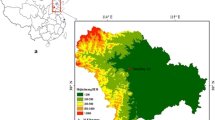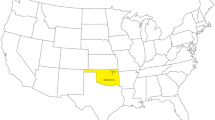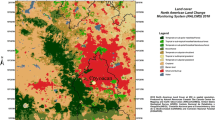Abstract
Since 1986 the atmosphere in Tulsa, Oklahoma has been monitored for airborne pollen and spores with a Burkard 7-day spore trap situated on the roof of a building at The University of Tulsa. The present study specifically examined the early spring tree pollen season for several local taxa and the occurrence of pre-season pollen during December and January. Knowledge of the local pollen season will help identify the presence of out-of-season pollen and possible long distance transport (LDT) events. Average daily concentrations of airborne pollen for species ofBetula, Quercus, Ulmus, and Cupressaceae were determined for each year from 1987 to 1996. The data showed that during the early spring the precise pollination periods for these allergenic tree species are highly variable. There were considerable variations in start date, season length, peak concentration, date of peak, and cumulative season total. The start dates forUlmus, Betula, andQuercus varied by 30 days or more, while the early spring Cupressaceae pollen showed the least variation in start date (only 23 days). More research is needed to understand the mechanisms which govern the onset and magnitude of pollen release. Although several reports have documented episodes of long distance transport (LDT) of pollen, the actual contribution of out-of-season or out-of-region pollen to local air spora is poorly known. The current study also re-examined the LDT ofJuniperus ashei pollen in Oklahoma.Juniperus pollen appeared in the Tulsa atmosphere on 40% of the days in December and January with concentrations as high as 2400 pollen grains/m3 of air; however, no local populations ofJuniperus pollinate at this time of the year. High concentrations occurred on days with southerly winds suggesting thatJuniperus ashei populations in southern Oklahoma and Texas were the pollen source. Since no local pollen is present in the Tulsa atmosphere in December and January, this example of LDT has been easy to document.
Similar content being viewed by others
References
Andersen TB. A model to predict the beginning of the pollen season. Grana 1991;30:269–75.
Boyer WD. Air temperature, heat sums, and pollen shedding phenology of longleaf pine. Ecology 1973;54(2):420–6.
Buck P, Distribution and Identification of Woody Plants of Oklahoma in the Winter Condition. Norman, OK: Oklahoma Academy of Science, 1983.
Cambon G, Ritchie JC, Guinet P. Pollen marquer de transports a longue distance dans l’atmosphere du sud de l’Ontario (Canada). Can J Bot 1992;70:2284–93.
Chang WWY, Pollen survey of the United States. In: Patterson R, Grammer LC, Greenberger PA, Zeiss CR, editors, Allergic Diseases—Diagnosis and Management, 4th ed. Philadelphia: J.B. Lippincott, 1993:159–194.
Christie AD, Ritchie JC. On the use of isentropic trajectories in the study of pollen transports. Nat Can 1969;96:531–49.
Comtois P, Mandrioli P. The aerobiological results from the 1994 cruise of the Urania (cnr) on the Adriatic. I. Pollen and spore counts on the Mediterranean Sea as compared to mainland Italia. Aerobiolgia 1996;12:167–72.
Crawford K, The Oklahoma Mesonet, Norman, OK: Oklahoma Climatological Survey, 1993.
Gutman AA, Bush RK, Allergens and other factors important in atopic disease. In: Patterson R, Grammer LC, Greenberger PA, Zeiss CR, editors, Allergic Diseases—Diagnosis and Management, 4th ed. Philadelphia: J.B. Lippincott, 1993:93–158.
Frenguelli G, Spieksma FTM, Bricchi E, Romano B, Mincigrucci G, Nikkels AH, Dankaart W, Ferranti F. The influence of air temperature on the starting dates of the pollen season ofAlnus andPopulus. Grana 1991;30:196–200.
Hall SA. Pollen deposition and vegetation in the southern Rocky Mountains and southwest Plains USA. Grana 1990;29:47–61.
Hjelmroos M. Evidence of long-distance transport ofBetula pollen. Grana 1991;30:215–28.
Hjelmroos M. Long-distance transport ofBetula pollen grains and allergic symptoms. Aerobiologia 1992;8:231–6.
Lejoly-Gabriel M, Leuschner RM. Comparison of air-borne pollen at Louvain-la-Neuve (Belgium) and Basel (Switzerland) during 1979 and 1980. Grana 1983;22:59–64.
Levetin E, A re-evaluation of aeroallergens in northeast Oklahoma. 8th Conf. Biometeorol. Aerobiol., Preprint vol., Boston, MA: American Meteorological Society, 1987:283–285.
Levetin E, Buck P. Hay fever plants of Oklahoma. Ann Allergy 1980;45:26–32.
Levetin E, Buck P. Evidence of mountain cedar pollen in Tulsa. Ann Allergy 1986;56:295–9.
Lindgren D, Paule L, Xihuan S, Yazani R, Segerstrom U, Wallin JE, Lejdebro ML. Can viable pollen carry Scots pine genes over long distances? Grana 1995;34:64–9.
Pathirane L. Graphical determination of the main pollen season. Pollen Spores 1975;17:609–10.
Peeters AG, Zoller H. Long range transport ofCastanea sativa pollen. Grana 1988;27:203–8.
Persson S, Nilsson S, Co-variational analysis of pollen season characteristics. In: Nilsson S, Raj B, editors, Nordic Aerobiology. Stockholm: Alingust and Wiskelli Int. 1984;43–46.
Ritchie JC, Lichti-Federovich S. Pollen dispersal phenomena in Arctic-Subarctic Canada. Rev Paleobot Palynol 1967;3:255–66.
Solomon A, Pollen. In: Edmonds RL, editor, Aerobiology—The Ecological Systems Approach. Stroudsburg, PA: Dowden, Hutchinson, and Ross, 1979:41–54.
Snook EC, Distribution of eastern redcedar on Oklahoma rangelands. In: Wittwer RF, Engle DM, editors. Proc. Eastern Redcedar in Oklahoma Conf., Oklahoma State University, Stillwater, OK, 1985:45-52.
Spieksma FTM, Emberlin JC, Hjelmroos M, Jager S, Leuschner RM. Atmospheric birch (Betula) pollen in Europe: Trends and fluctuations in annual quantities and the starting dates of the seasons. Grana 1995;34:51–7.
Wallin JE, Segerstrom U, Rosenhall L, Bergman E, Hjelmroos M. Allergic symptoms caused by long-distance transported birch pollen. Grana 1991;30:265–8.
Wodehouse RP, Hay Fever Plants, New York: Hafner, 1971.
Author information
Authors and Affiliations
Rights and permissions
About this article
Cite this article
Levetin, E. A long-term study of winter and early spring tree pollen in the Tulsa, Oklahoma atmosphere. Aerobiologia 14, 21–28 (1998). https://doi.org/10.1007/BF02694591
Accepted:
Issue Date:
DOI: https://doi.org/10.1007/BF02694591




